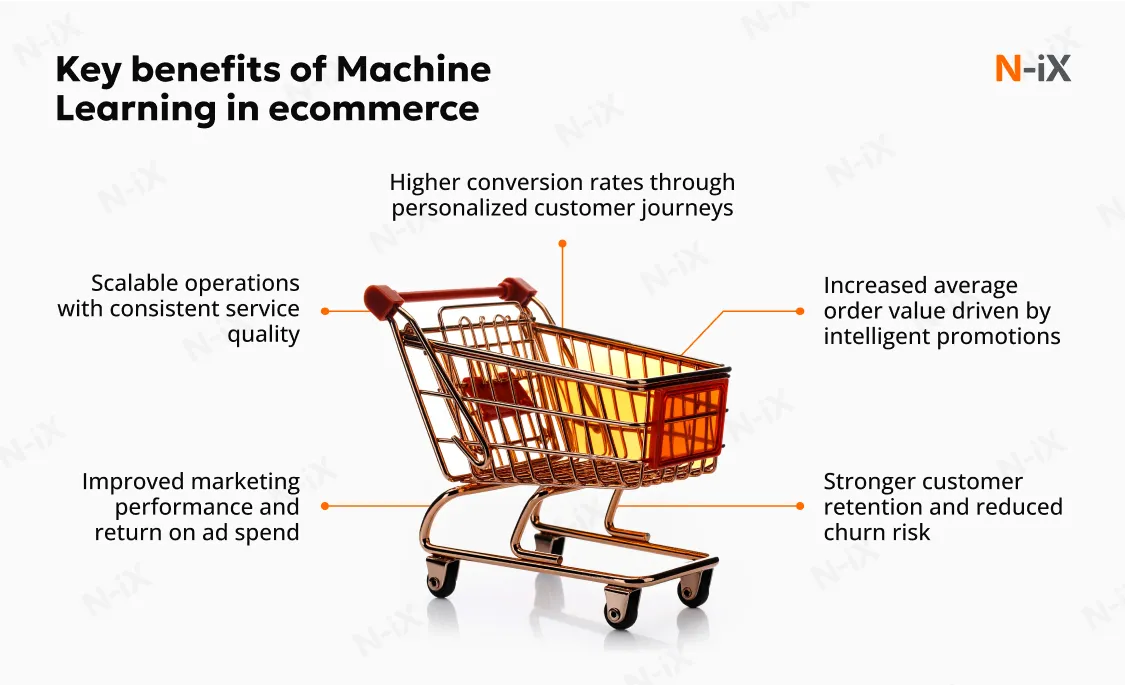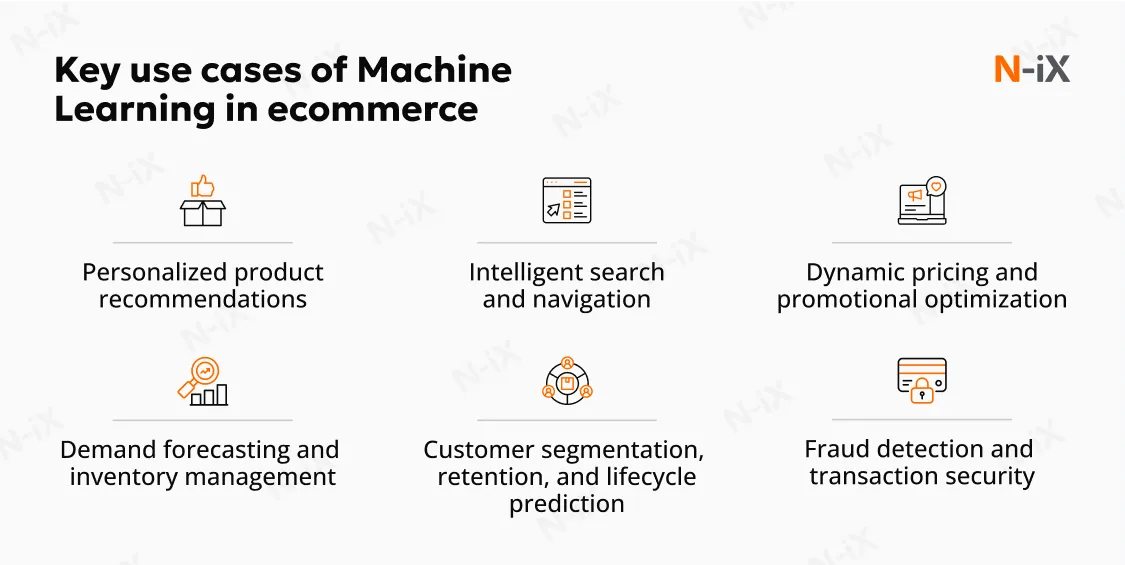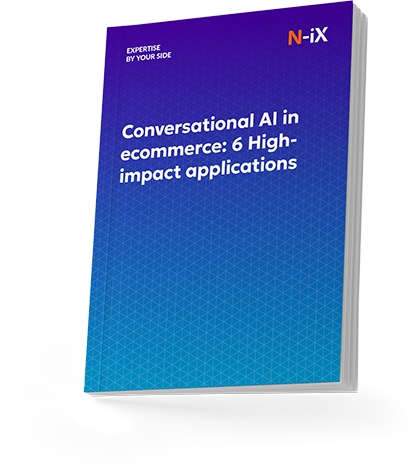Machine Learning in ecommerce enables businesses to drive personalized customer experiences, optimize operations, and make data-informed decisions faster. This technology supports a wide range of ecommerce applications, from product recommendations and dynamic pricing to churn prediction and fraud detection. Such capabilities help businesses unlock new revenue streams, reduce operational overhead, and respond to customer behavior in real time. ML adoption is accelerating rapidly: according to McKinsey, 78% of organizations now use AI at least for one business case, up from 72% in early 2024 and 55% the year before [1].
As ecommerce businesses scale and customer expectations rise, building these capabilities in-house becomes increasingly complex. Effective implementation requires cloud-native infrastructure, seamless platform integration, and continuous retraining pipelines. That’s why many companies choose to work with experienced ecommerce software development partners that can deliver end-to-end ML solutions tailored to their business goals.
Why should you use Machine Learning in ecommerce?
Adopting Machine Learning across your ecommerce operations brings measurable gains in revenue, efficiency, and customer satisfaction.
This technology will enable you to:
Increase conversion rates through personalized experiences
Machine Learning provides highly relevant product recommendations, adjusts website content in real time, and guides users toward purchases that match their preferences. McKinsey reports that 71% of consumers expect personalized interactions, and 76% feel frustrated when those expectations are not met [2]. Addressing this demand leads to higher conversion rates and stronger brand affinity.
Grow average order value with targeted promotions
ML algorithms analyze browsing behavior, purchase history, and customer segments to suggest bundled products or time-sensitive offers. These tactics encourage customers to add more items to their carts. According to McKinsey, 65% of customers identify targeted promotions as a key reason to complete a purchase, directly impacting basket size and transaction value [3].
Retain high-value customers and reduce churn
Application of Machine Learning in ecommerce uncovers customer behavioral patterns that indicate declining engagement or switching risk. With timely interventions, such as loyalty rewards, personalized reactivation offers, or tailored content, businesses can maintain stronger customer relationships and increase lifetime value. Predicting churn helps to reduce it, protect margins, and lower acquisition pressure.
Improve marketing efficiency and ROI
ML enables data-driven optimization across advertising channels, creative formats, and timing. Campaigns reach the right audience with minimal waste, and performance improves continuously through feedback loops. Budget allocation becomes more precise, supporting growth without inflating acquisition costs.
Scale operations without compromising quality
Machine Learning supports growth by automating key workflows such as inventory management, fraud detection, and customer segmentation. These capabilities allow ecommerce businesses to scale up without overextending operational teams. Quality of service remains high, even as order volumes and customer expectations increase.

Read more: Generative AI in ecommerce: Use cases and challenges
What are the key Machine Learning use cases in ecommerce?
Leading ecommerce businesses apply Machine Learning across the entire value chain—from customer experience to pricing, inventory, and fraud prevention. Here is how Machine Learning can be used in ecommerce to deliver the most value:

Personalized product recommendations
Machine Learning models analyze customer behavior, browsing history, and purchase patterns to suggest relevant products in real time. These systems increase both click-through and conversion rates by reducing the time needed to find desired items. Personalized recommendation engines also help increase average order value through strategic upselling and cross-selling. For ecommerce companies, particularly during high-volume periods like Black Friday, personalization becomes essential, since over 40% of ecommerce leaders generate more than 10% of annual revenue from such shopping events [4].
More on the topic: Customer service analytics
Learn where conversational AI drives the most value in ecommerce—get the white paper!


Success!

Intelligent search and navigation
ML-driven search engines improve product discovery by interpreting vague or imprecise queries, ranking results by predicted relevance, and personalizing category hierarchies. These capabilities reduce bounce rates and cart abandonment, especially for mobile-first users or during peak traffic. Intelligent navigation also minimizes friction, guiding users to high-converting products faster and with less manual effort.
Dynamic pricing and promotional optimization
Price volatility and promotional saturation make it difficult for ecommerce companies to maintain margins while staying competitive. Machine Learning in ecommerce enables dynamic pricing by factoring in real-time supply, competitor pricing, seasonality, and user behavior. It also optimizes the timing and targeting of promotions.
For example, trade promotions can account for up to 20% of revenue in food and beverage retail, but many companies lack the analytics tools to evaluate their effectiveness [5]. ML systems synthesize historical promotion and stock data to recommend future offers that perform better and cost less to execute. In a market where 80% of retail executives cite price wars as a critical challenge, dynamic pricing tools are essential for sustained profitability [6].
Demand forecasting and inventory management
Machine Learning models forecast product demand with higher accuracy by integrating multiple data sources, including historical sales, seasonality, promotions, and external factors such as weather or economic signals. These forecasts inform smarter inventory planning, helping reduce overstock, avoid stockouts, and minimize warehousing costs. Accurate demand prediction becomes especially critical during high-velocity shopping periods, where supply mismatches can result in lost revenue or customer dissatisfaction.
Customer segmentation, retention, and lifecycle prediction
ML algorithms group customers by behavior, purchase history, channel preferences, and predicted value. These segments enable ecommerce companies to tailor communications, launch loyalty campaigns, and adjust timing based on lifecycle stage. Predictive models flag when high-value users may churn and recommend interventions such as targeted discounts or personalized outreach. These efforts improve retention and maximize customer lifetime value while reducing dependence on constant acquisition spending.
Fraud detection and transaction security
Ecommerce platforms face growing threats from fraudulent transactions, account takeovers, and bot activity. Machine Learning enhances fraud prevention by continuously learning from transaction patterns and detecting anomalies in real time. Unlike static rule-based systems, ML adapts to new fraud tactics quickly, reducing false positives and enabling legitimate transactions to proceed without friction. Stronger fraud prevention improves trust and lowers financial exposure across high-risk payment channels.
Discover the use cases of NLP in ecommerce
How to adopt Machine Learning in ecommerce?
Implementing Machine Learning involves aligning data, infrastructure, and operational processes across the ecommerce ecosystem. A phased roadmap helps reduce complexity, lower risk, and ensure measurable business outcomes at every stage.
1. Ensure data readiness and labeling
Machine Learning depends on clean, structured, and relevant data. Ecommerce businesses must start by auditing existing customer, product, and transaction data to identify gaps and inconsistencies. Data must be centralized and labeled correctly to train effective models. For example, product descriptions should be standardized, and customer behaviors should be tracked with clear intent markers.
Common blocker: Incomplete or siloed data.
N-iX tip: Establish a unified data strategy, integrate sources via APIs or data lakes, and invest in data cleaning tools or expert support early in the process.
2. Select the right ML models or technology partners
Ecommerce leaders face a strategic choice: build proprietary models in-house or adopt proven, third‑party solutions. Decision factors include internal expertise, project velocity, and the complexity of business use cases. Off‑the‑shelf platforms can effectively address standard requirements, such as recommendation engines or pricing algorithms. Custom models offer precision and differentiation when tackling niche product categories, unique customer segments, or loyalty-first engagements.
Common blocker: Lack of in-house ML expertise.
N-iX tip: Partner with ML implementation vendors, cloud providers, or AI consulting firms that have domain experience in ecommerce and understand retail-specific constraints.
How N‑iX brings value: N‑iX combines retail domain expertise with strong ML capabilities to support end-to-end ecommerce transformation. Our 200 data experts specialize in Machine Learning, AI, NLP, and computer vision. As an AWS Premier Tier partner, we build ML solutions from strategy and PoC to production pipelines using managed platforms like SageMaker or custom MLOps toolchains. With more than 60 data projects delivered across ecommerce, retail, supply chain, and digital commerce, we help businesses implement Machine Learning technology in ecommerce for personalization, dynamic pricing, and predictive operations at scale.
3. Integrate with your digital commerce stack
ML models must be embedded into existing ecommerce platforms, such as Shopify, Magento, and BigCommerce, to deliver value in real time. Integration involves API connectivity, UI adjustments, and testing for performance at scale. ML outputs, such as product recommendations or pricing adjustments, should be surfaced directly in customer-facing channels.
Common blocker: Technical debt or platform rigidity.
N-iX tip: Use modular architectures and ML platforms with pre-built connectors or SDKs. Plan for gradual rollout by testing features in lower-risk segments before platform-wide deployment.
4. Set up monitoring and model retraining
ML models degrade over time as customer behavior, inventory dynamics, or market conditions evolve. Continuous monitoring is essential to detect drops in accuracy or relevance. Retraining schedules should be established based on model type and data volatility. Feedback loops from users and A/B testing results can inform adjustments.
Common blocker: Performance degradation without early warning.
N-iX tip: Implement real-time dashboards and automated alerts for KPIs like conversion lift, click-through rate, or fraud detection accuracy. Assign ownership to a dedicated ML operations team or partner.
Enhancing ecommerce services with ML-powered churn prediction: Success story by N-iX
Our client, a subscription and online retail service provider, needed to identify customers at risk of churn. Frequent cancellations and declining activity eroded recurring revenue, and manual analysis failed to detect early warning signs. The client faced limited customer segmentation, no churn prediction capabilities, and heavily manual marketing processes. All of these factors limited retention efforts and personalized outreach.
N‑iX implemented a robust, end‑to‑end ML‑powered churn prediction solution deployed on AWS. Our team created a PoC, designed the system architecture, and organized the workflow using a structured work breakdown. Moving to production, our experts deployed a serverless, AWS-native solution: SageMaker for churn model training, plus Lambda and Step Functions to orchestrate campaigns. The system captured user behavior and email interaction data, calculated churn probabilities, and used those scores to trigger automated, personalized campaigns. A React-based template manager empowered marketers to quickly build and reuse email campaigns without coding.
As a result of cooperation, our client:
- Improved customer retention through early detection and personalized re‑engagement;
- Increased email engagement with targeted communications;
- Reduced manual workload and enabled marketing teams to focus on strategy.
Conclusion
Machine Learning in ecommerce helps companies to perfect personalization, efficiency, and scale. However, achieving these benefits requires data maturity, seamless integration, and continuous optimization. Building and maintaining such capabilities internally may be complex, which is why partnering with an experienced software development provider becomes a strategic decision.
N‑iX is a trusted technology partner with over 23 years in the market, 2,400 professionals on board, and a strong track record in data and AI. We offer end-to-end Machine Learning services tailored to the needs of ecommerce clients: from data engineering and model development to platform integration and post-deployment support.
Whether you're looking to reduce churn, optimize promotions, or unlock predictive insights, N‑iX provides the technical expertise and industry experience to turn your ML initiatives into business outcomes.
References
- McKinsey & Company. The state of AI: How organizations are rewiring to capture value. 2023.
- McKinsey & Company. What is personalization?
- McKinsey & Company. Unlocking the next frontier of personalized marketing.
- McKinsey & Company. Power forward: Five make-or-break truths about next-gen ecommerce.
- McKinsey & Company. Fortune or fiction? The real value of a digital and AI transformation in CPG.
- Deloitte. 2025 US Retail Industry Outlook.
Have a question?
Speak to an expert




